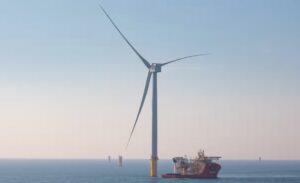Australian researchers have claimed a new world efficiency record for solar panels that can directly split water using sunlight, in an achievement that opens up a new pathway to low-cost renewable hydrogen.
The achievement has been published in the research journal Advanced Energy Materials, and was led by a team of scientists at the Australian National University.
The researchers were able to demonstrate an “unprecedented” milestone of 17.6 per cent solar to hydrogen efficiency using a “tandem” solar cell, that layered low-cost perovskite materials on top of a conventional silicon solar cell to boost efficiency.
“This represents the highest efficiency achieved so far for a [photoelectrochemical] system based on inexpensive semiconductors for stand-alone solar water splitting,” the research paper says.
“As revealed by our modelling results, the proof-of-concept demonstration offers immense opportunities to further improve the efficiency and reduce costs through optimisation of the performances of the individual components and replacement of precious catalysts with abundant materials.”
The conventional method of using renewable energy to produce hydrogen is by using electricity produced from solar panels or wind turbines to power a standalone electrolyser, which uses the electricity to split water into hydrogen and oxygen.
The innovative approach to solar panel technology developed by the ANU researchers, led by Dr Siva Karuturi and Dr Heping Shen effectively skips this second step, with solar panels themselves designed to directly convert water into hydrogen within the panels.
The ANU researchers compared the process of used by the solar cell that directly converts solar power into hydrogen to that of photosynthesis used by plants.
“Achieving global renewable energy transition further relies on addressing the intermittency of solar electricity through the development of transportable energy storage means,” the research paper says.
“An elegant and potentially economical route to storing solar power is to convert the energy from sunlight directly into hydrogen in a photoelectrochemical cell, analogous to the photosynthesis process exploited by nature.”
Currently, this method is cost prohibitive as the “photoelectrochemical” technique has been demonstrated at comparatively low efficiencies. However, with the Australian-based research team successfully demonstrating how the efficiency of the direct solar-to-hydrogen process can be improved, it raises the genuine prospect that a cost-effective design is within reach.
One of the lead researchers, Dr Siva Karuturi told RenewEconomy that there were significant cost benefits to be achieved through the use of the solar-to-hydrogen as it avoids the need for added power and network infrastructure necessary when hydrogen is instead produced using an electrolyser.

By avoiding the need to convert solar power from DC to AC power and back again, in addition to avoiding power transmission loses, the direct conversion of solar energy into hydrogen within the solar panel itself can achieve a higher overall efficiency for the total process.
Part of the challenge to date has been the lower efficiencies of previous designs, and the tendency for perovskite solar cells to degrade over time.
The United States department of energy set a 20% efficiency target for solar-to-hydrogen technologies, that would allow the technique to become cost-competitive with other hydrogen production methods, and the ANU researchers believe further refinements to their approach could help achieve that goal.

Renewable hydrogen has emerged as the subject of immense focus within the energy sector, as a means for both storing zero-emissions energy, and serving as an alternative source of thermal energy that could displace coal and natural gas in industrial processes.
The research received funding support from the Australian Renewable Energy Agency and the Australian Research Council. There is a significant amount of research currently being undertaken in Australia towards improving next generation solar technologies, like perovskite solar cells.
Earlier in the year, ANU researchers announced that they had achieved a new world record for tandem solar cell efficiency, also using the combined silicon cell and perovskite design, achieving a 27.7 per cent conversion efficiency.
In May, researchers at the University of Sydney revealed that they had overcome some of the key reliability challenges for perovskite solar cells, announcing that they had passed strict durability tests for perovskite solar cells in a key step towards their wide-scale commercialisation.







